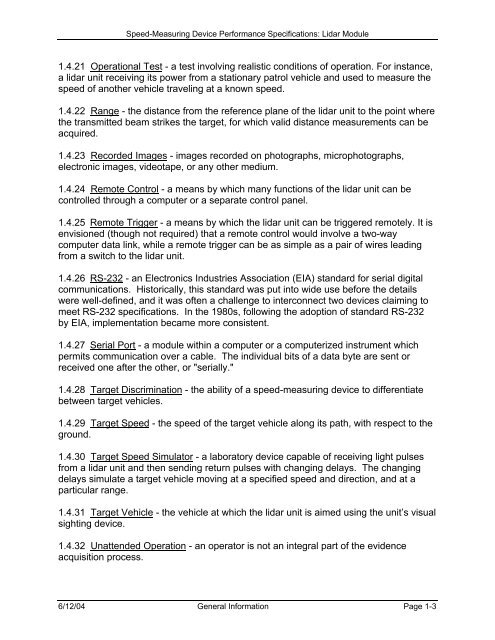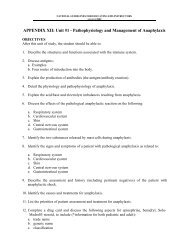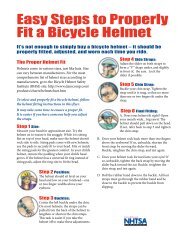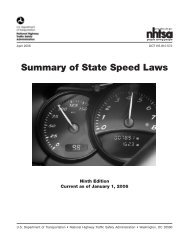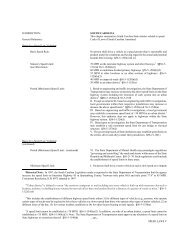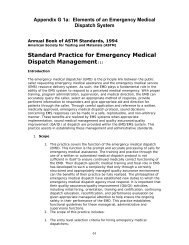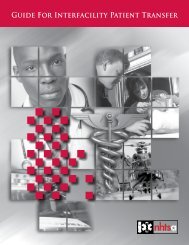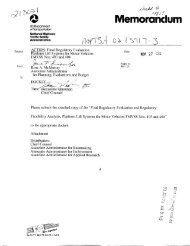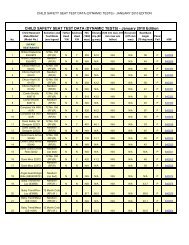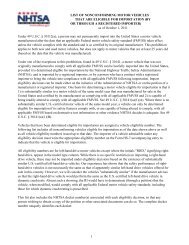Speed-Measuring Device Performance Specifications: Lidar Module
Speed-Measuring Device Performance Specifications: Lidar Module
Speed-Measuring Device Performance Specifications: Lidar Module
You also want an ePaper? Increase the reach of your titles
YUMPU automatically turns print PDFs into web optimized ePapers that Google loves.
<strong>Speed</strong>-<strong>Measuring</strong> <strong>Device</strong> <strong>Performance</strong> <strong>Specifications</strong>: <strong>Lidar</strong> <strong>Module</strong><br />
1.4.21 Operational Test - a test involving realistic conditions of operation. For instance,<br />
a lidar unit receiving its power from a stationary patrol vehicle and used to measure the<br />
speed of another vehicle traveling at a known speed.<br />
1.4.22 Range - the distance from the reference plane of the lidar unit to the point where<br />
the transmitted beam strikes the target, for which valid distance measurements can be<br />
acquired.<br />
1.4.23 Recorded Images - images recorded on photographs, microphotographs,<br />
electronic images, videotape, or any other medium.<br />
1.4.24 Remote Control - a means by which many functions of the lidar unit can be<br />
controlled through a computer or a separate control panel.<br />
1.4.25 Remote Trigger - a means by which the lidar unit can be triggered remotely. It is<br />
envisioned (though not required) that a remote control would involve a two-way<br />
computer data link, while a remote trigger can be as simple as a pair of wires leading<br />
from a switch to the lidar unit.<br />
1.4.26 RS-232 - an Electronics Industries Association (EIA) standard for serial digital<br />
communications. Historically, this standard was put into wide use before the details<br />
were well-defined, and it was often a challenge to interconnect two devices claiming to<br />
meet RS-232 specifications. In the 1980s, following the adoption of standard RS-232<br />
by EIA, implementation became more consistent.<br />
1.4.27 Serial Port - a module within a computer or a computerized instrument which<br />
permits communication over a cable. The individual bits of a data byte are sent or<br />
received one after the other, or "serially."<br />
1.4.28 Target Discrimination - the ability of a speed-measuring device to differentiate<br />
between target vehicles.<br />
1.4.29 Target <strong>Speed</strong> - the speed of the target vehicle along its path, with respect to the<br />
ground.<br />
1.4.30 Target <strong>Speed</strong> Simulator - a laboratory device capable of receiving light pulses<br />
from a lidar unit and then sending return pulses with changing delays. The changing<br />
delays simulate a target vehicle moving at a specified speed and direction, and at a<br />
particular range.<br />
1.4.31 Target Vehicle - the vehicle at which the lidar unit is aimed using the unit’s visual<br />
sighting device.<br />
1.4.32 Unattended Operation - an operator is not an integral part of the evidence<br />
acquisition process.<br />
6/12/04 General Information Page 1-3


